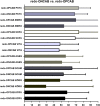Clinical outcome and quality of life after reoperative CABG: off-pump versus on-pump - observational pilot study
- PMID: 23561396
- PMCID: PMC3622626
- DOI: 10.1186/1749-8090-8-66
Clinical outcome and quality of life after reoperative CABG: off-pump versus on-pump - observational pilot study
Abstract
Background: Coronary artery bypass grafting (CABG) on cardiopulmonary bypass (CBP) is associated with significant morbidity and mortality. In high-risk patients, doomed for reoperation the adverse effects of CBP may be more striking. We evaluated the results of reoperative CABG (redo-CABG) by either off-pump (OPCAB) or on-pump (ONCAB). Clinical endpoints were perioperative myocardial infarction, mortality, survival and as the most striking difference between prior studies the quality of life (QoL).
Methods: We performed a prospective, non-randomized assessment for patients who underwent redo-CABG by redo-OPCAB (n=40) or redo-ONCAB (n=40) at our institution between January 2007 and December 2010. For evaluation of QoL the SF-36 health survey was used with self-administered assessment.
Results: During follow-up 37 of 40 patients were alive in the redo-OPCAB group versus 32 of 40 patients in the redo-ONCAB group (p<0.05). The shorter operation time, less blood loss, fewer perioperative myocardial infarctions, the higher rate of totally arterial revascularisation and shorter intensive care stay were the significantly beneficial differences for patients in the redo-OPCAB group (p<0.05). The 3-year survival rate was higher in the redo-OPCAB group with 81 ± 12% versus 63 ± 9%in the redo-ONCAB group. The quality of life survey did not reveal any significant differences between both groups.
Conclusion: In conclusion, with our present retrospective study, we could demonstrate the safety and efficacy of the redo-OPCAB technique with even higher 3-year survival rate. Both techniques seem to have similar impact on the outcome of patients.
Figures



References
MeSH terms
LinkOut - more resources
Full Text Sources
Other Literature Sources
Medical

